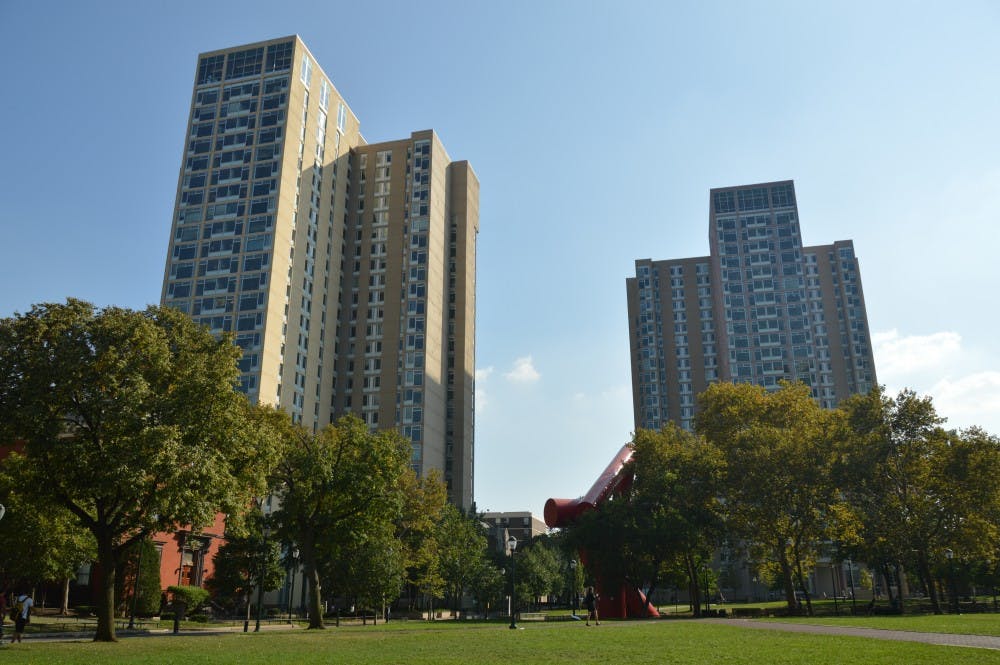Today, Penn's three high rises are home to nearly 2,400 students, but much has changed since they started housing undergraduates in the 1970s.
From high rise semi-formals, which are no longer organized, to campus uproar in response to a photo of students having sex against a high rise window, the stories that have happened in these three buildings are far from boring. Here's a quick look into this colorful, and often, surprising history:
In 1968, the University acquired land between 38th and 40th streets, now known as Hamilton Village, to expand its residential capacity for an increasingly large student body despite fierce opposition from existing residents of the area.
Constructed in the early 1970s, the new t-shaped buildings were designed by George Holmes Perkins, former Dean of the Graduate School of Fine Arts. At the time, students said it was more important for the new buildings to have comfortable and modern apartment-style interiors rather than attractive exteriors.
The high rises were named after several prominent figures in University history, but until recently, students commonly called the buildings High Rise East (Harnwell College House), High Rise South (Harrison College House) and High Rise North (Hamilton, now called Rodin College House). They referred to the area as the "Superblock."
Several residential programs made their homes in the high rises early on, including the Arts House Residential Program and international programs like the East Asia House Residential Program, both currently located in Harnwell.
Kent Bream, faculty director of Harnwell house, medical professor and 1990 College graduate, has lived in Harnwell as a faculty member for a total of 10 years.
He said that when he was a student the high rises had “dark brown windows that couldn’t really close.” From a distance, due to the development of the city, the high rises “dominated the skyline” of West Philadelphia. He added that at the time few people wanted to live in the high rises because living there seemed “dark” and “miserable.”
In 1998, the University planned an overhaul of Hamilton Village, including the repair of all three high rises, costing more than $380 million. After financial setbacks and delays, an $80 million renovation of the high rises began in 2002.
Judith Rodin, the president of the University from 1994 to 2004, was heavily involved in the renovations, which included upgrading the elevator systems, installing a new fire alarm system and fire sprinklers in all rooms, repairing and coloring the buildings’ concrete facades and landscaping parts of Hamilton Village. Hamilton College House was renamed Rodin College House in her honor.

Bream said he remembers how renovators “gutted everything,” exposing a honeycomb-like interior as they installed floor-to-ceiling windows and repainted walls.
After the renovations, students resumed living in the buildings, and the community in the high rises continued to grow. In 2003, Front Row Theatre Company became Harrison’s in-house theater company and also became a residential program within the house.
Bream said the high rises used to have highly anticipated “semi-formals,” which no longer occur, though the remnants of the tradition live on in Harnwell’s annual Sapphire Ball.
Frank Pellicone, dean of Harrison College House, has lived for 17 years in Harrison and said that “staff and faculty have become much more integrated in students’ lives” since he has served as house dean and that students have grown more enthusiastic about houses’ programming. He cites the Dinner and Conversation series with faculty and courses taught in residence as examples of increased interaction between students and staff.
In 2005, what started as a risque photo turned into legal charges when a student shared a photo online of a couple having sex against a Rodin College House window. The Engineering junior who took the photo was charged with sexual harassment, but in the end, neither the couple nor the photographer were punished.
In 2009, the high rises became more exclusive to upperclassmen when Rodin stopped admitting freshmen. Harnwell College House followed suit in 2013.
Pellicone said the loss of the four-year-living status and freshmen was a “disappointment.”
“Four-year-students really understand the traditions and culture of the house,” Pellicone said. He added that he thinks the higher participation rates of younger students that events enjoy and the mentorship they receive from older students are benefits of living in a four-year college house.
According to Bream, Harnwell had about 60 students per year who had lived in the college house for all four years.
One reason for the exclusion of freshmen from the high rises was so administrators could better accommodate the housing preferences of a larger number of upperclassmen. Pellicone also said he thinks the introduction of new dorms like New College House has decreased the need for freshman space in the high rises.



